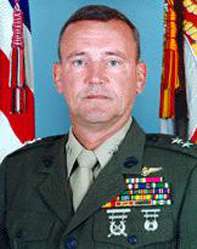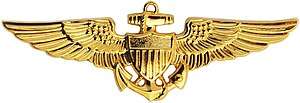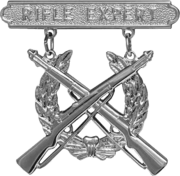Joseph T. Anderson
Joseph T. "Joe" Anderson (born February 21, 1946) is a retired United States Marine Corps general officer, combat veteran, and test pilot. During his military service, he made notable contributions to the Marine Corps' use of the Harrier Jump Jet. After retirement, he provided senior leadership to multiple organizations including the National Air and Space Museum. In 2017, Anderson retired from air show flying.
Joseph T. Anderson | |
|---|---|
 Anderson in 1998 | |
| Nickname(s) | Joe |
| Born | February 21, 1946 Detroit, Michigan, U.S. |
| Allegiance | |
| Service/ | |
| Years of service | 1968–2001 (33 years) |
| Rank | |
| Commands held | VMA-331 Marine Aircraft Group 13 1st Marine Aircraft Wing |
| Battles/wars | Vietnam War |
| Awards | |
| Other work | Business executive airshow pilot |
Early life
Anderson was born in Detroit, Michigan, on February 21, 1946. He graduated from Detroit Catholic Central High School in 1964. He received an appointment to the United States Naval Academy in Annapolis, Maryland. After graduating in 1968 with a Bachelor of Science degree in Engineering, Anderson was commissioned a Second Lieutenant in the United States Marine Corps.[1]
Military career
Anderson attended The Basic School in Quantico, Virginia, and was selected to attend Undergraduate Pilot Training with the United States Air Force at Craig Air Force Base, Alabama. Upon receiving Air Force Silver Wings, he reported for duty to Marine Corps Air Station Yuma, Arizona, earning his U.S. Navy Wings of Gold and becoming combat qualified in the F-4 Phantom. He remains one of the very few pilots to be awarded both U.S. Air Force and U.S. Navy pilot wings.[2] He served with Marine Fighter Attack Squadron 314 (VMFA-314) at Marine Corps Air Station El Toro flying the McDonnell Douglas F-4 Phantom II. In 1971, Anderson was assigned to the "Silver Eagles" of VMFA-115 where he flew combat missions in the Republics of Vietnam and Thailand. Upon return from Vietnam in 1973, he transitioned to the Hawker Siddeley Harrier (AV-8A) when he served with Marine Attack Squadrons VMA-231 and VMA-542, and also with Marine Attack Training Squadron VMAT-203.[1]
In addition to his normal duties, Anderson earned a Master of Science degree in Systems Engineering from the University of Southern California (USC).[1]
In 1975, Anderson attended the United States Naval Test Pilot School located at Naval Air Station (NAS) Patuxent River in Patuxent River, Maryland.[1] He graduated with Class 70 and remained at NAS Patuxent River to participate in a number of test programs including development of procedures to operate the Harrier from the Landing Helicopter Assault (LHA) class of naval vessels. In 1982, Anderson implemented these procedures during a deployment to the Mediterranean with VMA-231 aboard the USS Nassau (LHA-4).[3] He participated in the testing of the prototype YAV-8B Harrier II and supported Initial Operational Test and Evaluation (IOT&E) of the AV-8B Harrier II.[4] Anderson served in increasingly responsible roles including executive officer of VMA-231, researcher at the Institute for Defense Analysis, and systems and engineering officer for the AV-8. In 1985, he was selected to attend the National War College at Fort Lesley J. McNair in Washington, D.C. After graduation, Anderson was assigned as the commanding officer of VMA-331 flying the McDonnell Douglas AV-8B Harrier II. In 1990, he was assigned as the commanding officer of Marine Aircraft Group 13 in Yuma, Arizona. In 1993, Anderson was selected for promotion to Brigadier General and served as director of the USMC Operations Division and then as vice commander of Naval Air Systems Command.[1]
Anderson was promoted to Major General in 1997 and assigned as the Assistant Chief of Staff for Command, Control, Communications, Computer and Intelligence (C4I). In April 1998, he assumed command of the 1st Marine Aircraft Wing in Okinawa, Japan.[1] After 33 years of service and 219 combat missions,[5] Anderson retired from the U.S. military in 2001.[6]
Civilian career
_explains_future_growth_plans_for_the_National_Air_and_Space_Museum_in_Chantilly%2C_Va.%2C_to_Air_Force_Secretary_Dr._James_G._Roche_on_Dec._21%2C_2004.jpg)
After retiring from the Marine Corps, Anderson started a second career as a senior executive for aerospace corporations including vice president for business development at Advanced Navigation and Positioning Corp and corporate vice president of the Dalcorp Advisory Group.[5] In 2003, he accepted the position of associate director at the National Air and Space Museum's Steven F. Udvar-Hazy Center annex near Chantilly, Virginia.[6] In 2006, Anderson founded an outreach program known as NASM on the Road that provided convalescing soldiers from local military hospitals with a visit to the museum.[5] A laptop provided a virtual tour of the museum to service members who were unable to leave the hospital.[7] In 2007, Anderson was promoted to deputy director of the facility and served in that position until his departure from the museum in 2009.[6] Anderson also held positions on the boards of directors for a number of organizations including the Navy Federal Credit Union, Peduzzi Associates Ltd., Draken International, and the National Museum of the United States Air Force.[5]
Anderson has remained active in community service. In 2004, he spoke at the Turning Goals Into Reality (TGIR) Awards Ceremony that celebrated the year's most significant accomplishments for the National Aeronautics and Space Administration.[8] In 2008, he appeared in the movie, America's Marine Aviators, where he spoke on the importance of close air support and the value of the F-35 Lightning II to the Marine Corps. In 2014, he presented a lecture on effective leadership to the university and community of Findley, Ohio.[9] Anderson is also a volunteer pilot for Angel Flight Patient Airlift Services and volunteers as a Court Appointed Special Advocate (CASA) for neglected and abused children.[5]
Air show pilot
Joe Anderson, America's Marine Aviators[10]
In 2008, Anderson joined the team of fellow retired Marine aviator, Art Nalls, that restored a civilian-owned Sea Harrier to flying status. The two have flown both the Harrier and a Czech Aero Vodochody L-39 Albatros jet trainer in air shows along the eastern United States.[11][12] The group is in the process of adding a two-seat trainer Harrier and additional pilots to their fleet.[13] In 2017, after nearly a decade of flying, Anderson retired from the air show circuit.[14]
Personal life
Anderson and his wife, Marcia, reside in Virginia and have two daughters—Amy Iler and Jane Burns.[15] He is a member of a number of professional and military organizations including the Marine Corps Aviation Association, the Early and Pioneer Naval Aviation Association (Golden Eagles), and the Society of Experimental Test Pilots.[5]
Awards and decorations
Anderson was awarded the following decorations for his military service.[1]
 | |||
 |
 | ||
| Insignia | Naval Aviator insignia | |||||||||||||||
|---|---|---|---|---|---|---|---|---|---|---|---|---|---|---|---|---|
| Row 1 | Defense Distinguished Service Medal | Navy Distinguished Service Medal | ||||||||||||||
| Row 2 | Defense Superior Service Medal | Legion of Merit | Meritorious Service Medal | Air Medal w/ valor device and Strike/Flight numeral "13" | ||||||||||||
| Row 3 | Navy and Marine Corps Commendation Medal | Navy Unit Commendation | Navy Meritorious Unit Commendation | Air Force Outstanding Unit Award | ||||||||||||
| Row 4 | National Defense Service Medal | Armed Forces Expeditionary Medal | Vietnam Service Medal w/ 1 service star | Navy Sea Service Deployment Ribbon | ||||||||||||
| Row 5 | Vietnam Gallantry Cross with gold star | Vietnam Gallantry Cross Unit Citation | Vietnam Civil Actions Medal Unit Citation | Vietnam Campaign Medal | ||||||||||||
| Badge | Rifle Expert badge (13 awards) | Pistol Expert badge (16 awards) | ||||||||||||||
See also
- List of 1st Marine Aircraft Wing Commanders
- List of historic United States Marines
- List of United States Marines
Notes
- Official Biography 2012.
- "Bio: Joe Anderson (Major General, USMC, Ret.)". Artnalls.com. Retrieved 2017-02-18.
- Nordeen 2006, p. 83.
- Nordeen 2006, p. 114.
- Patterson 2014.
- Golkin & McNally 2007.
- York 2016.
- NASA 2004.
- Filby 2014.
- Altman 2008.
- Kaplan 2011.
- Trimble 2010.
- BayNet 2014.
- Nalls 2017.
- Avino 2006.
References
- "Official Biography: Major General Joseph T. Anderson". Washington, D.C.: United States Marine Corps. Archived from the original on March 4, 2012. Retrieved May 9, 2016.
- Altman, Dana (Director) (May 9, 2008). America's Marine Aviators (DVD). Omaha, Nebraska: North Sea Films.
- Avino, Mark (2006). "Don Lopez , Glindel Lopez, Marsha Anderson, and General Joe Anderson". Washington, D.C.: National Air and Space Museum. Retrieved June 1, 2016.
- Filby, Max (April 9, 2014). "Retired general stresses service". The Courier. Findley, Ohio: The Findlay Publishing Company. Archived from the original on June 25, 2016. Retrieved May 27, 2016.
- Golkin, Peter; McNally, Frank (January 25, 2007). "Joseph T. Anderson Named Deputy Director for National Air and Space Museum's Steven F. Udvar-Hazy Center". Washington, D.C.: National Air and Space Museum. Retrieved May 26, 2016.
- Kaplan, Michael (February 7, 2011). "How to Restore a Harrier Jump Jet". Popular Mechanics. Harlan, Iowa: Hearst Communications. Retrieved August 7, 2015.
- Nalls, Art (2016). "Joe Anderson, MGen, USMC (ret)". California, Maryland: Nalls Aviation. Retrieved May 31, 2016.
- Nalls, Art (November 16, 2017). "Joe Anderson Retires (at least for a while)". California, Maryland: Nalls Aviation. Retrieved May 8, 2020.
- Nordeen, Lon O. (2006). Harrier II, Validating V/STOL. Annapolis, Maryland: Naval Institute Press. ISBN 1-59114-536-8.
- Patterson, Brianna (March 28, 2014). "Marine Corps Major General to Give Presentation on Effective Leadership at The University of Findlay". Findley, Ohio: University of Findley. Retrieved May 27, 2016.
- "Second Harrier Jet added to Nalls Aviation Fleet". The BayNet. Hollywood, Maryland: Logan Ventures. November 8, 2014. Retrieved June 3, 2016.
- Trimble, Stephen (December 18, 2010). "Sea Harrier revived by former USMC pilot for air show circuit". Flightglobal. New York, New York: Reed Business Information. Retrieved May 31, 2016.
- "Turning Goals Into Reality 2004 (TGIR) Speaker Biographies". Washington, D.C.: National Aeronautics and Space Administration. July 14, 2004. Archived from the original on February 21, 2013. Retrieved May 1, 2017.
- York, Scott K. (January 21, 2009). "Board of Supervisors Meeting". Loudoun County. Leesburg, Virginia: Loudoun County Government. Retrieved June 2, 2016.
Attribution

External links
| Wikimedia Commons has media related to Joseph T. Anderson. |
- "Joseph T. Anderson, Maj Gen USMC (Ret.)" (PDF). Cardiff, California: Early and Pioneer Naval Aviators Association (Golden Eagles). Retrieved May 25, 2016.
- "Joseph T. Anderson on IMDB". Internet Movie Database. Retrieved May 26, 2016.
- Nalls, Art. "Joe Anderson, MGen, USMC (ret)". California, Maryland: Nalls Aviation. Retrieved May 26, 2016.
- Nalls, Art (1978). "Joe Anderson and John Farley Ski Jump 1978". California, Maryland: Nalls Aviation. Retrieved June 2, 2016.
- Nalls, Art (August 2015). "Maj Gen (Ret) Joe Anderson: Versatile Test Pilot, Aerial Combat Vet" (PDF). California, Maryland: Nalls Aviation. Retrieved June 2, 2016.
- "Pilot Joe Anderson Talks About The L-39 & The Sea Harrier". CBS Local. New York City, New York: CBS Radio, Inc. August 15, 2015. Archived from the original on June 10, 2018. Retrieved June 10, 2018.
- "Valor Awards for Joseph T. Anderson". MilitaryTimes. Springfield, Virginia: Sightline Media Group. Retrieved May 9, 2016.
- Voelter, Markus (May 26, 2014). 148 - Flying the Harrier (Podcast). Stuttgart, Germany: Omega Tau. Retrieved June 2, 2016.